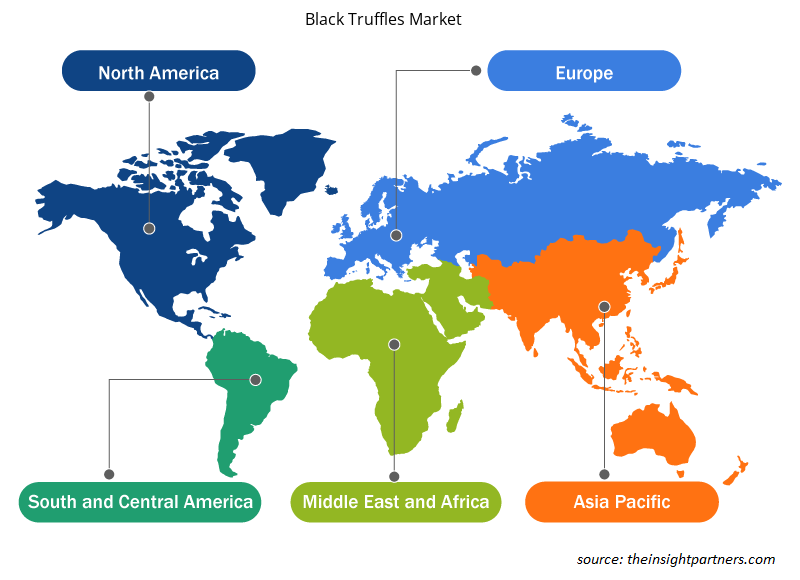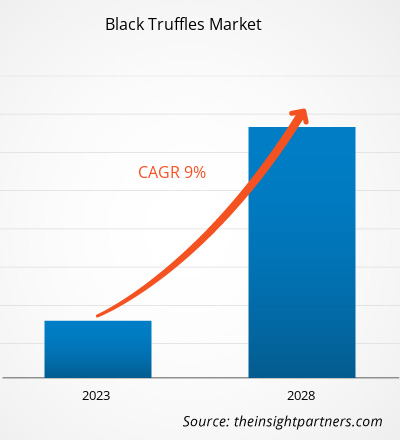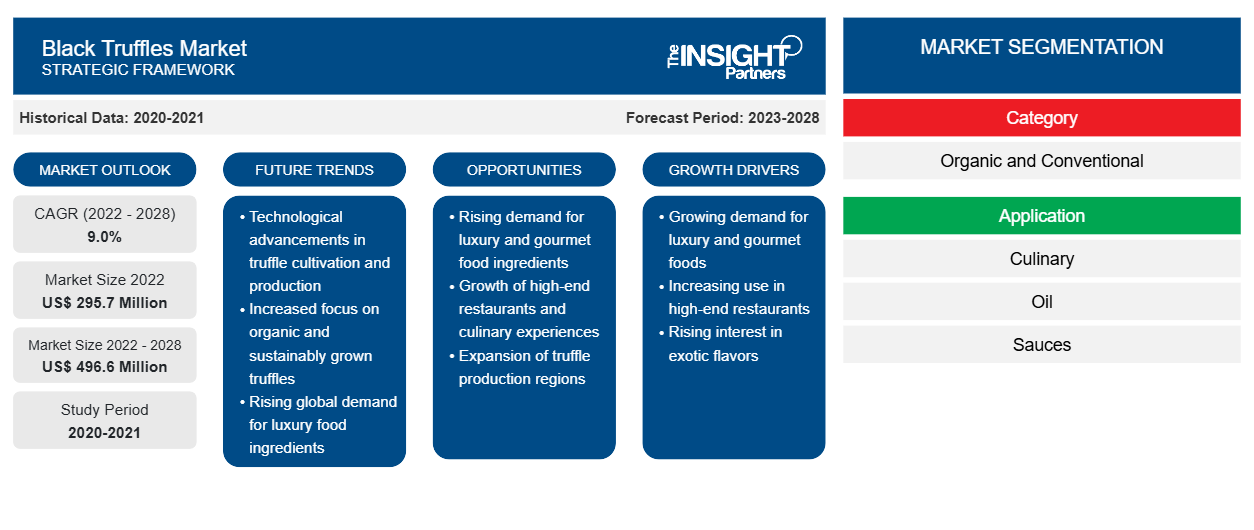Se proyecta que el tamaño del mercado de trufas negras crecerá de US$ 295,7 millones en 2022 a US$ 496,6 millones en 2028; se espera que crezca a una CAGR del 9,0% entre 2022 y 2028.
La trufa negra (Tuber melanosporum), también conocida como trufa de Perigord o trufa negra de invierno, se encuentra de forma silvestre en toda Europa desde noviembre hasta febrero, aunque la temporada puede variar ligeramente. Recientemente, la trufa negra de invierno se ha cultivado con éxito en Australia y Nueva Zelanda. Las trufas negras son hongos ectomicorrízicos, por lo que suelen encontrarse en estrecha asociación con las raíces de los árboles. Las trufas negras se utilizan principalmente en la cocina italiana y francesa. Las trufas negras tienen sabores y aromas únicos. El sabor de la trufa negra tiene notas terrosas con un toque de menta, pimienta y avellana. Las trufas negras son las preferidas por muchos gourmets debido a su perfil de sabor único. A menudo, los chefs llaman a la trufa negra el "diamante de la cocina".
Impacto de la pandemia de COVID-19 en el mercado de la trufa negra
En 2020, varias industrias tuvieron que reducir la velocidad de sus operaciones debido a las interrupciones en las cadenas de valor y suministro causadas por el cierre de las fronteras nacionales e internacionales. La pandemia de COVID-19 afectó negativamente a las economías y las industrias debido a los confinamientos, las prohibiciones de viaje y los cierres de empresas. Las interrupciones en las cadenas de suministro de materias primas clave y las irregularidades en los procesos de fabricación debido a las restricciones impuestas por las autoridades gubernamentales tuvieron un impacto directo en la industria de alimentos y bebidas. Estos factores afectaron negativamente al mercado de trufas negras durante la pandemia de COVID-19. Sin embargo, en 2021, el mercado fue testigo de una recuperación positiva cuando los gobiernos anunciaron la relajación de las restricciones impuestas anteriormente. A los fabricantes se les permitió trabajar a plena capacidad, aprovechando su rentabilidad. Se espera que este factor impulse el mercado en los próximos años.
Personalice este informe según sus necesidades
Obtendrá personalización en cualquier informe, sin cargo, incluidas partes de este informe o análisis a nivel de país, paquete de datos de Excel, así como también grandes ofertas y descuentos para empresas emergentes y universidades.
- Obtenga las principales tendencias clave del mercado de este informe.Esta muestra GRATUITA incluirá análisis de datos, desde tendencias del mercado hasta estimaciones y pronósticos.
Perspectivas del mercado
Iniciativas de innovación de productos por parte de los usuarios finales
Los fabricantes de trufa negra están invirtiendo significativamente en investigación y desarrollo, asociaciones y colaboraciones para lanzar productos innovadores que atraigan a una gran base de consumidores. Los vendedores de alimentos y bebidas están lanzando nuevos productos a base de trufa, como salsas y aceites, que impulsan el consumo de trufas negras en el mercado global. En 2018, deRosario, el fabricante con sede en EE. UU., lanzó una gama de condimentos de trufa elaborados con trufas, incluido el aceite de trufa negra y el aceite de oliva virgen extra. En 2020, PS Gourmet Pe lanzó su aceite de trufa negra en Singapur. En noviembre de 2022, TRUFF, un fabricante con sede en Australia, ingresó al espacio de los condimentos con "TRUFF Black Truffle Salt". La opción de condimento presenta una mezcla de sal marina fina y gruesa con una cantidad determinada de trufas negras. Estos lanzamientos de productos ayudan a las empresas a establecer relaciones a largo plazo con los consumidores finales.deRosario, the US-based manufacturer, launched a range of truffle Pe launched its black truffle oil in Singapore. In November 2022, TRUFF, an Australia-based manufacturer, entered into the seasoning space with "TRUFF Black Truffle Salt." The condiment option features a mix of fine and coarse sea salt with a purposeful amount of black truffles. Such product launches help companies establish long-term relationships with end-use consumers.
Tipo de información
Según la categoría, el mercado de trufas negras se segmenta en orgánico y convencional. Se proyecta que el segmento orgánico registre una CAGR más alta durante el período de pronóstico. La trufa negra orgánica se cultiva en suelo libre de fertilizantes químicos (como nitrógeno sintético, fosfato y potasa) e ingredientes modificados genéticamente. Los herbicidas y pesticidas sintéticos también se evitan en el cultivo de trufa negra orgánica. En su lugar, los productores utilizan estimuladores de crecimiento orgánicos para cultivar trufas negras orgánicas. En general, las trufas negras orgánicas son más caras que las trufas convencionales debido a su calidad superior. Las empresas se están centrando en lograr certificaciones orgánicas para abordar la creciente demanda de trufas negras orgánicas en el mercado.CAGR during the forecast period. Organic black truffle is cultivated in soil free from chemical fertilizers (such as synthetic nitrogen, phosphate, and potash) and genetically modified ingredients. Herbicides and synthetic stimulators to cultivate organic black truffles. Generally, organic black truffles are more expensive than conventional truffles due to their superior quality. Companies are focusing on achieving organic certifications to address the rising demand for organic black truffles in the market.
Información sobre aplicaciones
Según la aplicación, el mercado de las trufas negras se segmenta en culinario; aceite; salsas, cremas para untar y mantequilla; y otros. El segmento culinario tuvo la mayor participación del mercado en 2021. Las trufas negras se rallan en salsas a base de vino o crema o se raspan sobre pasta cocida, huevos revueltos o platos de papa. Las trufas negras se agregan como aderezo a varios productos alimenticios para mejorar su sabor y darles una apariencia más opulenta. Además, las trufas negras se agregan como ingredientes de guarnición a las comidas de carne y para dar un sabor fuerte a la comida. También se utilizan para producir sal de trufa y miel de trufa. Algunos tipos de quesos especiales también contienen trufas negras. Estos factores están impulsando la demanda de trufas negras en aplicaciones culinarias.
Los principales actores que operan en el mercado de trufas negras incluyen Trufo, TRUFFUS SAS, L'Aragonais Food Supplies SL, SABATINO NA LLC, LAUMONT TRUFFLES SLU, Arotz SA, Les Freres Jaumard SaRL, Perigord Truffles of Tasmania Pty Ltd, Great Southern Truffles Pty Ltd y Old World Truffles. Estos actores se centran en proporcionar productos de alta calidad para satisfacer las demandas de los clientes. También se centran en estrategias como inversiones en actividades de investigación y desarrollo y lanzamientos de nuevos productos.
Perspectivas regionales del mercado de trufas negras
Los analistas de Insight Partners han explicado detalladamente las tendencias y los factores regionales que influyen en el mercado de trufas negras durante el período de pronóstico. Esta sección también analiza los segmentos y la geografía del mercado de trufas negras en América del Norte, Europa, Asia Pacífico, Oriente Medio y África, y América del Sur y Central.

- Obtenga los datos regionales específicos para el mercado de trufas negras
Alcance del informe sobre el mercado de trufas negras
| Atributo del informe | Detalles |
|---|---|
| Tamaño del mercado en 2022 | US$ 295,7 millones |
| Tamaño del mercado en 2028 | US$ 496,6 millones |
| CAGR global (2022-2028) | 9.0% |
| Datos históricos | 2020-2021 |
| Período de pronóstico | 2023-2028 |
| Segmentos cubiertos | Por categoría
|
| Regiones y países cubiertos | América del norte
|
| Líderes del mercado y perfiles de empresas clave |
|
Densidad de actores del mercado de trufas negras: comprensión de su impacto en la dinámica empresarial
El mercado de las trufas negras está creciendo rápidamente, impulsado por la creciente demanda de los usuarios finales debido a factores como la evolución de las preferencias de los consumidores, los avances tecnológicos y una mayor conciencia de los beneficios del producto. A medida que aumenta la demanda, las empresas amplían sus ofertas, innovan para satisfacer las necesidades de los consumidores y aprovechan las tendencias emergentes, lo que impulsa aún más el crecimiento del mercado.
La densidad de actores del mercado se refiere a la distribución de las empresas o firmas que operan dentro de un mercado o industria en particular. Indica cuántos competidores (actores del mercado) están presentes en un espacio de mercado determinado en relación con su tamaño o valor total de mercado.
Las principales empresas que operan en el mercado de la Trufa Negra son:
- Trufo, Truffus SAS
- Suministros Alimentarios L'aragonais SL
- Sabatino Na LLC
- Trufas Laumont SLU
- Arotz SA
Descargo de responsabilidad : Las empresas enumeradas anteriormente no están clasificadas en ningún orden particular.

- Obtenga una descripción general de los principales actores clave del mercado de trufas negras
Informe Destacado
- Tendencias progresivas de la industria en el mercado de trufas negras para ayudar a los actores a desarrollar estrategias efectivas a largo plazo
- Estrategias de crecimiento empresarial adoptadas por las empresas para asegurar el crecimiento en los mercados desarrollados y en desarrollo
- Análisis cuantitativo del mercado de trufa negra de 2019 a 2028
- Estimación de la demanda mundial de trufas negras
- Análisis de las cinco fuerzas de Porter para ilustrar la eficacia de los compradores y proveedores de trufas negras
- Avances recientes para comprender el escenario competitivo del mercado
- Tendencia y perspectivas del mercado, junto con los factores que impulsan y restringen el crecimiento del mercado de trufas negras
- Asistencia en el proceso de toma de decisiones destacando las estrategias de mercado que sustentan el interés comercial.
- El tamaño del mercado de trufas negras en varios nodos
- Descripción detallada y segmentación del mercado, así como de la dinámica de la industria de alimentos y bebidas.
- Tamaño del mercado de trufas negras en diversas regiones con prometedoras oportunidades de crecimiento
Perfiles de empresas
- Trufo
- TRUFFUS SAS
- Suministros Alimentarios L'Aragonais SL
- SABATINO NA LLC
- TRUFAS LAUMONT SLU
- Arotz SA
- Los Hermanos Jaumard SaRL
- Trufas de Perigord de Tasmania Pty Ltd
- Grandes trufas del sur Pty Ltd
- Trufas del Viejo Mundo
- Análisis histórico (2 años), año base, pronóstico (7 años) con CAGR
- Análisis PEST y FODA
- Tamaño del mercado, valor/volumen: global, regional y nacional
- Industria y panorama competitivo
- Conjunto de datos de Excel
Informes recientes
Testimonios
Razón para comprar
- Toma de decisiones informada
- Comprensión de la dinámica del mercado
- Análisis competitivo
- Información sobre clientes
- Pronósticos del mercado
- Mitigación de riesgos
- Planificación estratégica
- Justificación de la inversión
- Identificación de mercados emergentes
- Mejora de las estrategias de marketing
- Impulso de la eficiencia operativa
- Alineación con las tendencias regulatorias





















 Obtenga una muestra gratuita para - Mercado de Trufas Negras
Obtenga una muestra gratuita para - Mercado de Trufas Negras